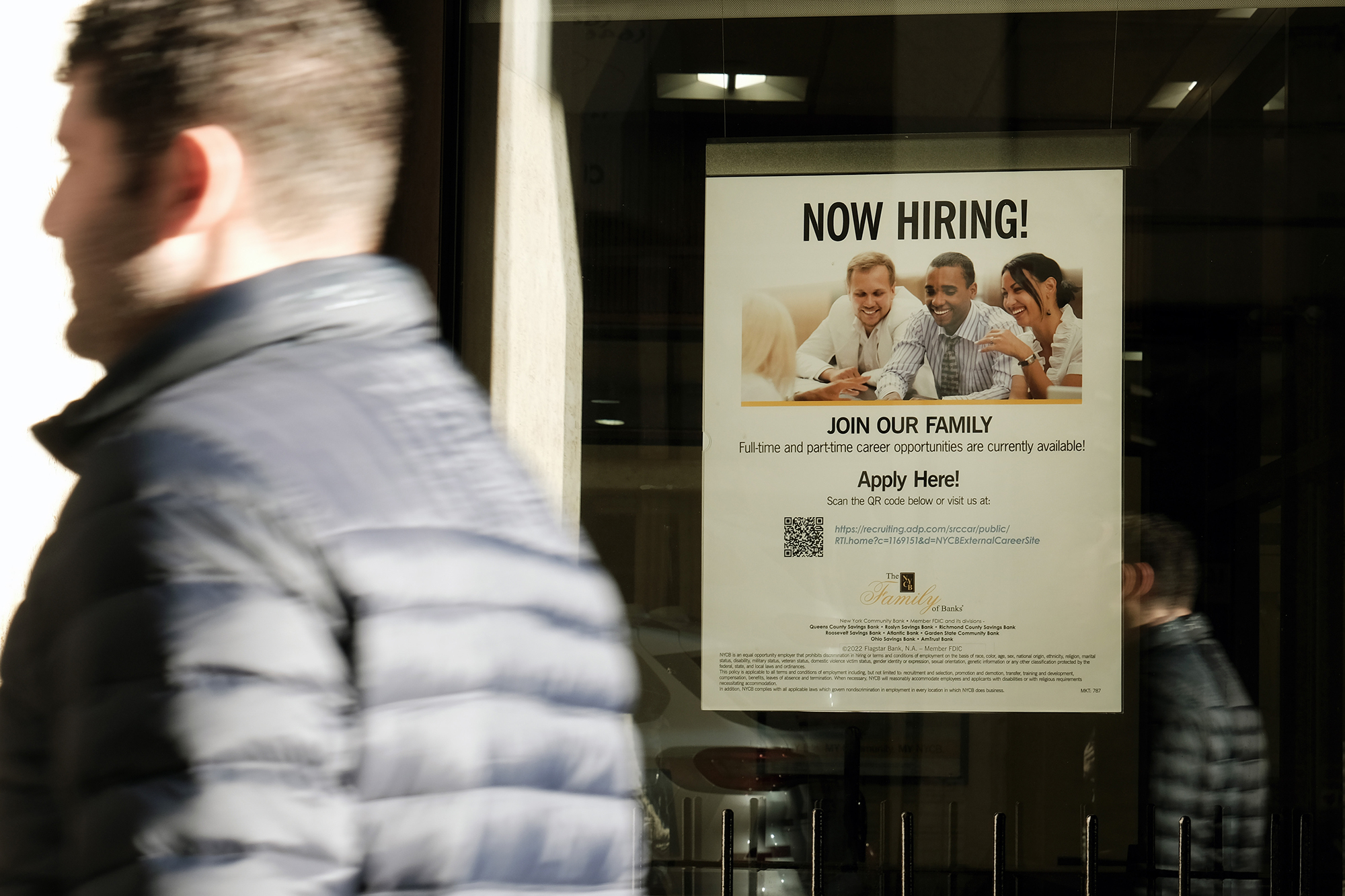
Jittery US markets await key jobs report
Global markets sink after sharp selloff in US bank stocks
Markets in Europe and Asia tumbled Friday following a sharp selloff in banking stocks in the United States as a major tech lender said it had to sell shares to plug a hole in its finances.
SVB Financial Group, which is partnered with nearly half of all venture-backed tech and health care companies in the United States, was forced to raise capital after it sold part of its portfolio of US Treasuries at a loss to cover a rapid decline in customer deposits.
Its stock cratered 60% on Thursday, and was down 46.6% in premarket trading on Friday.
“Lots of banks hold large portfolios of bonds and rising interest rates make these less valuable — the SVB situation is a reminder that many institutions are sitting on large unrealized losses on their fixed-income holdings,” commented Russ Mould, investment director at UK broker AJ Bell.
Europe’s benchmark Stoxx Europe 600 index fell 1.5% in early trading, while London’s bank-heavy FTSE 100 (UKX) index slid 1.8%.
The Stoxx Europe 600 Banks index, which tracks 42 big European banks, including those in the United Kingdom, sank by more than 4% Friday morning. Shares in banking giant HSBC (HSBC) tumbled nearly 5% Friday. The shares of Barclays (BCS) were down 3.4%, Deutsche Bank (DB) 7.4% and Italy’s Unicredit (UNCFF)3.6%.
In Asia, Hong Kong’s Hang Seng (HSNGY)led losses in the region, sinking 3%, while China’s Shanghai and Korea’s Kospi fell 1.4% and 1% respectively.
Asian markets have also been pressured this week because China has failed to announce any major economic stimulus during its National People’s Congress.
Meanwhile, Japan’s Nikkei ended Friday down 1.7% as the country’s central bank decided to keep its ultra-low interest rates unchanged.
US stocks dipped in pre-market trading. Futures on the benchmark S&P 500 (DVS) index fell 0.43%, while futures on the tech-heavy Nasdaq Composite (COMP) dropped 0.2%.
The losses come after US bank stocks logged the largest falls in nearly three years on Thursday. The KBW Bank Index, which tracks 24 leading US banks, fell 7.7%, its biggest drop in almost three years.
The selloff is a sharp turnaround for the global banking sector, which, until Thursday, had enjoyed surging stock valuations since last fall.
Wall Street is already on edge after Thursday’s losses
Fear overtook Wall Street Thursday after SVB Financial Group, a bank that lends primarily to tech companies, told investors it had to sell $1.75 billion in shares at a loss in order to cover rapidly declining customer deposits.
That triggered losses across the banking sector and concern that the Federal Reserve’s interest rate hikes are preventing banks from raising capital.
Bank stocks fell by their largest levels in nearly three years on Thursday, bringing all three major indexes down with them.
The Dow closed lower by 543 points, or 1.7%. The S&P 500 fell by 1.9% and the Nasdaq Composite was down 2.1%.
Silicon Valley-based SVB notched the largest decline in the sector, down by more than 60%, as CEO Greg Becker said the bank could be dealing with problems for some time to come.
Shares of JPMorgan Chase dropped by 5.4%, Bank of America fell 6.2%, Wells Fargo was down 6.2% and Citigroup was 4.1% lower.
When interest rates were near zero, large banks scooped up Treasuries and bonds. Now, as the Federal Reserve hikes rates to fight inflation, those bonds are worth much less and banks are sitting on the losses. For SVB, which said it is partnered with nearly half of all venture-backed tech and health care companies, cash-hungry startups are feeling the pinch.
Investors were also rattled ahead of Friday’s key employment report from the Labor Department, which they hope will provide some clarity on the Fed’s next policy moves.
Is it bad to have a good jobs report?

In January, there were nearly two job openings for each job seeker. The strong labor market means workers are enjoying the best wage growth in years — but that wage growth feeds into inflation.
“Let’s not question that it’s unequivocally good to see people with jobs and income,” ADP chief economist Nela Richardson told CNN. “What’s bad is that it’s coming at the cost of inflation.”
That’s one reason the Federal Reserve is penciling in a higher jobless rate in the quarters ahead, raising the ire of progressives like Senator Elizabeth Warren who accuses the Fed of trying to weaken the job market to achieve its inflation goals. By the Fed’s own estimate, higher rates could lead to unemployment in the mid 4% range, which would mean 2 million more people out of work.
It led to a testy exchange at the Senate Banking Committee hearing this week.
“If you could speak directly to the 2 million hardworking people who have decent jobs today, who you’re planning to get fired over the next year – what would you say to them?” Warren asked Powell.
“I would explain to them that inflation is very high,” Powell responded. “And it’s hurting the working people of this country badly. All of them, not just 2 million of them. But all of them are suffering from high inflation. And we are taking the only measures we have to bring inflation down.”
Essentially, the Fed thinks the needs of the many (keeping inflation in check for hundreds of millions of working people) outweigh the needs of the relatively few (the single-digit millions who may lose their jobs as the central bank purposefully slows the economy).
The next two weeks will serve as a crucial test on how much more medicine the economy needs. Friday’s jobs report, Tuesday’s CPI inflation report, Wednesday’s PPI inflation and retail sales reports, Thursday’s housing report, next Friday’s consumer sentiment report and the following Tuesday’s existing home sales will give the Fed a lot to think about ahead of its rate decision on March 22.
Why was the January jobs report such a blowout?

January’s blowout jobs number of 517,000 came in a month that is typically unique when it comes to labor market data due to seasonality factors and data adjustments. Here’s what’s going on:
Seasonal adjustments are made to help smooth out predictable periodic swings (such as holiday season hiring) to help better compare data and trends on an ongoing basis.
January’s report was also influenced by the Bureau of Labor Statistics’ annual benchmarking process to account for more current population and employment data.
Seasonality, benchmarking and the interplay of pandemic-era data don’t completely explain away January’s blockbuster jobs report, economists say, noting there are likely influences from the currently tight labor market.
“People didn’t actually lay off the people they usually do in January,” KPMG economist Diane Swonk told CNN. “January is the biggest layoff month, across the board, of any month out there; but even companies that saw demand waning a bit held on to workers.”
On an unadjusted basis, there was a 2.5 million decline in payrolls during January, BLS data shows. That’s the smallest unadjusted total for any January since 1995.
Unseasonably warm weather also likely played a role and could very well lead to a balmier-than-expected February jobs report, said Joe Brusuelas, chief economist at RSM, in a note this week.
Weather can cause fluctuations in employment, especially in industries such as construction, mining and natural resources, and leisure and hospitality, according to research from San Francisco Federal Reserve economists. Warm and sunny weather typically has a positive effect on employment.
“Even if there is a healthy downward revision to the January estimate, it will require another month at least for the noise in the data to be corrected and the true pace of hiring to be understood,” said Brusuelas.
What to expect from the jobs report

Economists estimate that the US economy added 205,000 jobs in February, according to Refinitiv, with an unemployment rate holding steady at 3.4%.
Despite widely publicized layoffs from tech giants, media companies and the financial sector in recent months, the US labor market remains robust after eight rate hikes meant to cool the economy.
In testimony before Congress this week, Federal Reserve Chairman Jerome Powell reiterated that the central bank will continue to hike its benchmark interest rate as long as necessary to tamp down historic inflation. While the central bank’s actions so far have slowed business investment and flash-frozen parts of the housing market, it has not crushed America’s white-hot jobs market.
“I think anything in excess of 230,000 to 250,000 job gains is going to be interpreted as a sign that the labor market is a lot more immune to higher lending costs than anyone anticipated,” Aaron Terrazas, Glassdoor’s chief economist, told CNN.
And that would mean higher interest rates are sure to follow, he added.
The Federal Reserve is keeping close watch on the dynamics within the US labor market as the central bank tries to rein in high inflation. While not the initial cause of this bout of inflation, the tight labor market has spurred concern among Fed officials that there’s an imbalance in wage negotiating that could put upward pressure on inflation.
Source: https://www.cnn.com/business/live-news/stocks-jobs-report-february/index.html















